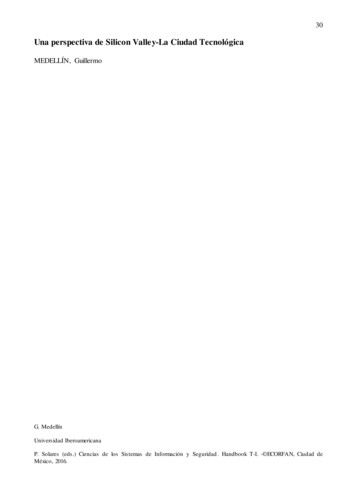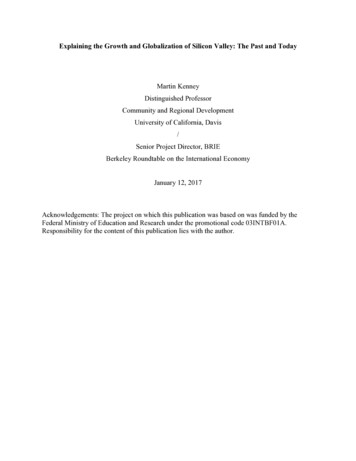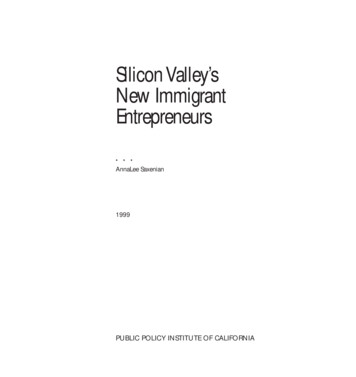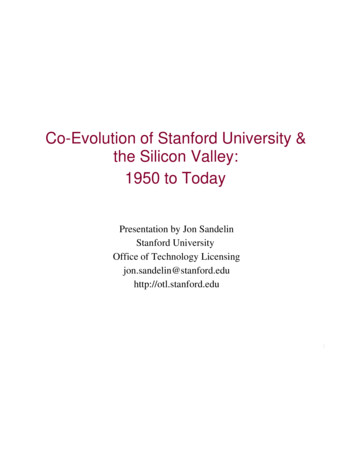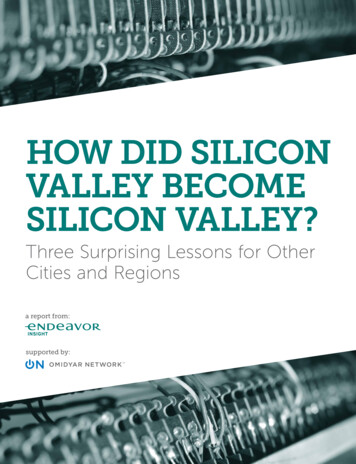
Transcription
HOW DID SILICONVALLEY BECOMESILICON VALLEY?Three Surprising Lessons for OtherCities and Regionsa report from:supported by:
2/How Silicon Valley Became "Silicon Valley"This report was created by Rhett Morris and Mariana Penido. They wish to thank JonaAfezolli, Fernando Fabre, Mike Goodwin, Matt Lerner, and Han Sun who provided criticalassistance and input. For additional information on this research, please contact Rhett Morris atrhett.morris@endeavor.org.
How Silicon Valley Became "Silicon Valley"/3PHOTO ON COVER: FLICKR USER MICHAEL KAPPEL PHOTO ON LEFT: A RECENT VIEW OF SILICON VALLEY AT NIGHT BY FLICKR USER PETERTHOENYINTRODUCTIONTHE JOURNALIST Don Hoefler coined theterm “Silicon Valley” in a 1971 article aboutcomputer chip companies in the San FranciscoBay Area.1 At that time, the region was home tomany prominent chip businesses, such as Inteland AMD. All of these companies used siliconto manufacture their chips and were located ina farming valley south of the city. Hoefler combined these two facts to create a new name forthe area that highlighted the success of thesechip businesses.Silicon Valley is now the most famoustechnology hub in the world, but it was a verydifferent place before these businesses developed. When the computer chip industry wasemerging in the mid-1950s, there were noventure capital investors in the area.2 StanfordUniversity did not produce any research on computer chip components and the supply of localemployees qualified to work with these hightech devices was almost nonexistent.3 The BayArea was far behind cities like Boston and NewYork in the chip industry.4 No one expected theregion to become a hub for these technologycompanies.Silicon Valley’s rapid development offersgood news to other cities and regions. Thisreport will share the story of its creation andanalyze the steps that enabled it to grow. Whileit is impossible to replicate the exact events thatestablished this region 50 years ago, the development of Silicon Valley can provide insightsto leaders in communities across the world. Itsstory illustrates three important lessons for cultivating high-growth companies and industries:1. Great companies can develop in unlikely and challenging places.2. A few entrepreneurs can make a largeimpact.3. There is a framework for success thatleaders can accelerate.Lessons for Cultivating High-Growth Companies & Industries1. GREAT COMPANIESCAN DEVELOP INUNLIKELY ANDCHALLENGING PLACES.2. A FEWENTREPRENEURSCAN MAKE A LARGEIMPACT.3. THERE IS AFRAMEWORK FORSUCCESS THAT LEADERSCAN ACCELERATE.Innovative businesses canstart up and become successful in cities and regionsthat are far from ideal.A very small group of successful founders has the power tospawn many companies thatcreate thousands of jobs.New companies can developrapidly when local entrepreneurs follow a cycle thatsupporters can speed up.
4/How Silicon Valley Became "Silicon Valley"The San Francisco Bay Area was a very difficult placefor the first computer chip entrepreneurs.nancing, customers, and employees — that werein short supply for startups like Shockley’s.11 In themid-1950s, there were no venture capital firms inthe Bay Area.12 The U.S. military often acted as themain funder and customer of high-tech companies.13 However, at that time only a small portionA GROUNDBREAKING INVENTION. In of the military’s startup capital and sales contractsthe late 1940s, a team of physicists at an AT&Twent to electronics firms in and around San Franresearch center in New Jersey created the trancisco.14 The Bay Area wasn’t even the leader in itsown state; Los Angeles and San Diego both resistor, a new “semiconductor” device that couldcontrol and amplify electric signals.5 The transis- ceived more funding for high-tech research andtor quickly began to replace other signal process- production.15It was also difficult to find talented employing technologies. It became so important that its6ees since engineers with semiconductor experthree inventors were awarded the Nobel Prize.In 1955, one oftise were concenthese inventors, atrated in cities thatMIT-trained scienalready had transistist named Williamtor companies. TheShockley, decidedBay Area did haveto leave the laboa small cluster ofratory and start atech firms, but thesecompany that procompanies workedduced transistors.7with technologiesShockley considthat were very difered locating hisferent from those inFarmworkersdryingprunesnearMountainView.company in Bostonthe transistor.16 Asa result, their employees lacked the knowledgeor Southern California, but he eventually chose to8return to the place where he grew up. In 1956, Shockley required.he started his new business in Mountain View, aStanford’s engineering program was alsosmall town in a farming valley 50 miles south of quite small. Fewer than 20 engineering PhDsSan Francisco.9graduated from the school the year Shockleystarted his firm.17 These graduates had little to noA REGION FULL OF CHALLENGES.experience working with transistors since StanShockley’s decision was quite surprising. As the ford did not have a semiconductor lab.18 In addition, strict immigration policies prevented localchart on the opposite page illustrates, the SanFrancisco area was far behind cities like Boston entrepreneurs from accessing talent from othercountries.19 In the 1950s and 1960s, immigrantsand New York in the the computer chip industry.10Research has also shown that building a success- made up less than 10% of the area’s populationful company requires access to three things — fi- — the lowest level in the last 150 years.20PHOTO AT CENTER: FLICKR USER CAMPBELL HISTORICAL MUSEUM & AINSLEY HOUSETHE BEST WAY to understand Silicon Valley’s success is to follow the story of its creation. This storybegins thousands of miles from the Bay Area ina laboratory where scientists developed the firstcomputer chip technology.
How Silicon Valley Became "Silicon Valley"/5DEVELOPMENT OF THE COMPUTER CHIPINDUSTRY’S FIRST TRANSISTOR COMPANIESMany cities were far ahead of the Bay Area.181521228Number ofactive transistorcompanies:41951Cities with B O S T O Nactive transistor CAM D ENcompanies:NEW SECAM D ENNEW YORKPATERSONPHILADELPHIACAM D ENNEW YORKCAM D ENNEW YORKPATERSONPATERSONPHOENIXDALL A SNEWARKPHILADELPHIAPHOENIXDALL A SNEWARKPHILADELPHIAELMIRACAM DENNEW YORKPATERSONPHOENIXDALL A SNEWARKPHILADELPHIAELMIRALOSANGELESMORRISTOWNCAM D ENNEW YORKPATERSONPHOENIXDALL A OSources: Tilton, 52. Klepper 79-116; Endeavor Insight analysis.THE VALLEY’S FIRST FAILURE. Shockleyworked hard to overcome these challenges. Hesecured financing from an investor outside theBay Area, but talent was more difficult to find.21 Heoffered jobs to his former co-workers at AT&T’sresearch lab, but they refused to move to the region.22 (The local area was so rural that it lackedlong distance telephone service.23) Researchersat RCA, another leading transistor company, alsoturned him down.24Since he could not hire experienced employees, Shockley tried to recruit the best young talentthat was available. He placed ads in academic journals and traveled across the U.S. to meet graduatestudents.25 This search yielded eight promising researchers and engineers who formed the core ofhis new firm. They included three PhDs from MITin Boston, a PhD and a professor from CalTech inSouthern California, two engineers from the NewYork area, and one local PhD from Stanford.26These men were quite young — their average agewas 30.27 Each was also hungry for new opportunities, which Shockley could provide. “It was like pickingup the phone and talking to God,” said Robert Noyce,one of the MIT PhDs. “He was absolutely the mostimportant person in semiconductor electronics.”28Although the company had a great team, it facedmajor problems before it could pursue customers.Shockley turned out to be a terrible boss.29 He insulted employees and was so paranoid that he once ordered his entire staff to take polygraph tests.30 Theseactions doomed his business. After just one year, alleight of the employees Shockley had worked so hardto recruit resigned on the same day.31Shockley’s company would shut down a fewyears later. The departure of the eight researchersweakened the firm to a point from which it could notrecover. It also left a key question unanswered: was iteven possible to build a competitive computer chipcompany in the Bay Area?
6/How Silicon Valley Became "Silicon Valley"A small group of ambitious entrepreneurs created thefirst successful chip company in the Bay Area.TWO SUPPORTERS MAKE A DIFFERENCE.The New York banker worked hard to convince theresearchers and engineers to launch their own firm.The team appreciated the quality of life in Northern California and had started to put roots down inthe area, which made them willing to give it a try.35“We all owned our own houses then,” rememberedGordon Moore, who was one of the eight researchers. “It was a heck of a lot easier than going out looking for another job.”36Unfortunately, it was more difficult than expected to find financing for a transistor company located in the Bay Area. Rock approached more than 35potential investors and was rejected every time.37He was about to stop searching when someoneintroduced him to a serial entrepreneur in New Yorknamed Sherman Fairchild. Fairchild agreed to fundthe new company as an independent business associated with Fairchild Camera & Instrument (FC&I),an electronics firm he led.38 The eight co-foundersnamed their company “Fairchild Semiconductor”and opened for business in Palo Alto in Octoberof 1957.39THE NEW FIRM TAKES OFF. Thanks toShockley’s recruiting and Rock’s fundraising, theentrepreneurs had plenty of talent and financing.All they needed were customers. Fortunately, Sherman Fairchild was well connected in the electronicsindustry. He introduced the co-founders to executives in the sector and helped them sign their firstcontract with IBM.40 This relationship gave themcredibility with other large clients. Military sales soonfollowed, including a prestigious contract to supplycomponents for the government’s new intercontinental missile program.41The entrepreneurs soon grew more ambitious.They began to develop integrated circuits with greater processing power.42 At the end of their third year,Fairchild’s annual revenues were over 20 million.43By the mid-1960s, the group was generating 90million in sales and was the second largest competitor in the chip industry.44 Yet this was only thebeginning of the co-founders’ accomplishments.PHOTO ON RIGHT: FLICKR USER WONDERLANEA NEW BEGINNING. Arthur Rock was a youngbanker working in New York when a colleaguehanded him a letter that would reshape the computer chip industry. It came from Eugene Kleiner, oneof the eight employees leaving Shockley’s company.“If suitable backing can be obtained, the presentgroup can reasonably expect to take with them othersenior people,” the message read. “We believe that weare much more valuable to an employer as a group.We have an experienced and well-diversified groupof men with background in the fields of physics, electronics, engineering, metallurgy, and chemistry.”32The eight men leaving Shockley wanted to continue working together to make transistors, but noother companies in the San Francisco area produced the devices.33 Kleiner’s father had contacts atthe bank where Rock worked. Kleiner reached out tothe bankers there because he hoped they could findan East Coast transistor company that would hire themen leaving Shockley as a team. The eight researchers had sacrificed promising careers to work together in this new industry. Most of them had movedtheir families a great distance. They weren’t ready togive up.Rock quickly recognized the group’s potential.“They had all been chosen by Shockley, so I knewthey were probably pretty good people, and thenwhen we met them I was very impressed,” he said.However, Rock thought the group should stoplooking for an employer and think much bigger. “Isuggested to them that they might want to set upa company, and we told them we would see if wecould get financing.”34
How Silicon Valley Became "Silicon Valley"/7TIMELINE OF FAIRCHILD SEMICONDUCTOR’SGROWTH AND ACCOMPLISHMENTS1956The eight co-founders met when they left their jobs to join Shockley Semiconductor.Most were new to the Bay Area.BOSTONNEW YORKLOS ANGELESJAY LASTCo-FounderPreviously earned aPhD at MITJULIUS BLANKCo-FounderPreviously at WesternElectricJEAN HOERNICo-FounderPreviously a professorat CaltechROBERT NOYCECo-FounderPreviously at Philco;earned a PhD at MITEUGENE KLEINERCo-FounderPreviously at WesternElectricGORDON MOORECo-FounderPreviously earned aPhD at CaltechPALO ALTOVICTOR GRINICHCo-FounderPreviously earned a PhDand conducted researchat StanfordSHELDON ROBERTSCo-FounderPreviously at Dow;earned a PhD at MIT1957The co-founders resigned and launched Fairchild Semiconductor with help from twokey supporters who provided funding and connections to early customers like IBM.ARTHUR ROCKBankerHayden, Stone & Co.SHERMAN FAIRCHILDInvestorFC&I1959The co-founders signed a contract to supply components to the new Minutemanmissile program.1960Fairchild recorded sales of 21 million and was the eighth largest player in its industry.The company also began production of the first integrated circuit. 21M 019571960 21MILLION INANNUAL SALES1963The company became the number three player in its industry and opened its firstoverseas assembly plant in Hong Kong.1965Fairchild Semiconductor recorded sales of 90 million. 90M 90MILLION INANNUAL SALES 21M 01957196619601965The company ranked second in its industry and employed over 4,000 people.Sources: Lecuyer 121, 131-149, 159-162, 204-207; Tilton 66; Endeavor Insight analsysis.
8/How Silicon Valley Became "Silicon Valley"These successful entrepreneurs reinvested their resourcesinto new companies to help spawn Silicon Valley.ALTHOUGH IT IS POSSIBLE to find great companies like Fairchild in unlikely places, it is rareto see those firms establish an entire local industry. However, this is exactly what happenedin the Bay Area.FAIRCHILD STARTS TO MULTIPLY. Theexpansion of the local computer chip industrybegan when Fairchild employees were inspiredby the eight co-founders and left the firm tolaunch “spin-off” businesses. In 1959, the firm’sgeneral manager left to start Rheem Semiconductor.45 Two groups of employees resigneda few years later to found the computer chipfirms Signetics and Molectro.46These actions had a significant impact on thepeople still working at Fairchild. “You got theseguys leaving and starting companies and thecompanies are running, working,” a formermanager said. “You get a look around and lookin the mirror and say, ‘Well, you know, howabout you? What are you going to do?’”47The eight co-founders committed their timeto supporting many of these ambitious new businesses. For example, when an employee wasconsidering starting a company to make the glasscomponents that Fairchild used in its manufacturing process, Kleiner encouraged himto launch the new firm.48 Noyce and anotherco-founder named Jean Hoerni also served onthe board of Applied Materials, an electronicsequipment firm, and mentored the company’syoung entrepreneur.49MORE NEW FIRMS EMERGE. Employeeswere not the only ones leaving Fairchild Semiconductor. The company’s success led Sherman Fairchild to exercise a buyout clause in hisinvestment contract and make the semicon-ductor firm a fully owned subsidiary of FC&I.50The sale made the eight co-founders rich, butit wasn’t long before many of them returned toentrepreneurial careers.“That experience of starting this company and watching it grow — I thought I’d liketo do that again,” recalled Jay Last, one ofthe co-founders.51 In 1961, he partnered withHoerni, Kleiner, and another one of the eightentrepreneurs to create Amelco, a new businessthat produced specialized devices that Fairchilddid not sell.52 Moore and Noyce resigned several years later to start Intel, which eventuallybecame the most successful computer chipcompany in the world.53The eight co-founders also reinvested theircapital into new startups. In 1961, four of themgave Rock funding to start the Bay Area’s firstventure capital firm, which went on to invest infifteen companies.54 Another founder provided financing that helped a former employeelaunch AMD.55 When Moore and Noyce started Intel, the other six co-founders of FairchildSemiconductor all helped to fund the newbusiness.56“That’s part of the legacy of Fairchild thatmaybe doesn’t get the attention it should,”Moore has said. “Every time we came up with anew idea, we spawned two or three companiestrying to exploit it.”57THE FAIRCHILD VALLEY. The commitment of the eight entrepreneurs to reinvesttheir knowledge and capital into these newly spawned companies transformed the localcommunity. When Fairchild Semiconductorwon its first contract in 1958, it was the onlycompany in the area producing computer chipsor their components. By the time that Hoefler
How Silicon Valley Became "Silicon Valley"/9THE CREATION OF SILICON VALLEY: GROWTH OFTHE LOCAL COMPUTER CHIP INDUSTRYFairchild generated 31 spinoff firms in just 12 years.Legend:Size of circle reflects the influence ofthe entrepreneurs at each companybased on the number of spinoff firms.wrote the article that coined the name “SiliconValley” less than 14 years later, over 30 spin-offcompanies had emerged out of Fairchild.58 Infact, according to Hoefler’s analysis, every localchip firm except for two could be traced directly back to the eight co-founders.59 The thrivingSPINOFFSSources: SEMI; Hoefler; Endeavor Insight analsysis.industry that grew out of Fairchild had a hugeeffect on the region. By 1970, the area was nolonger just a farming community. Chip businesses in the Valley employed a total of 12,000people.60
10/How Silicon Valley Became "Silicon Valley"The process of Silicon Valley’s creation can be illustratedby a cycle with four steps: ambition, growth, commitment, and reinvestment.STEP ONE: AMBITION The cycle beginswhen entrepreneurs seek to build large, scalablebusinesses in their local communities. To do this,they must have a strong desire to grow and apreference for living in the local area. Fairchild’sco-founders demonstrated both of these qualities when they took Rock’s advice and launchedtheir company in Mountain View. It is importantto note that ambitious entrepreneurs like this arequite rare. Studies in the U.S. have shown thatthe vast majority of small business owners donot want their companies to grow at all.61STEP TWO: GROWTH The second stepof the cycle occurs when ambitious foundersachieve significant growth at their companies.This requires them to have access to talent, financing, and customers. They must also possessthe ability to put these resources to use. Kleiner,Noyce, and the other entrepreneurs at Fairchild,had a tremendous amount of talent among theirfounding team. Rock’s work helped them access funding and Sherman Fairchild connectedthem to their first customers. The entrepreneurstook these resources and grew their companyto reach 20 million in sales in just three years.By 1966, it was the second largest competitorin its industry.STEP THREE: COMMITMENT The eightco-founders could have used the money theyreceived from the buyout of their company toleave the San Francisco area and enjoy an early retirement. Fortunately, they chose a different path. Instead of retiring somewhere else,the entrepreneurs stayed in the Bay Area anddedicated themselves to supporting new companies. This commitment is an example of thethird step in the Entrepreneurship AccelerationCycle, which requires successful founders tohave the desire to stay in their local area andshare their resources with the next generationof entrepreneurs.STEP FOUR: REINVESTMENT The finalstep of the cycle occurs when founders of successful companies are able to reinvest in other entrepreneurs and businesses. The leadersat Fairchild demonstrated the different waysthis can happen. They inspired employees tostart new companies and launched their ownspin-off businesses like Amelco and Intel. Theeight co-founders were early investors in thefirst venture capital firm in the Bay Area andin new companies such as AMD. They also mentored other local computer chip entrepreneurs.These actions helped a new generation ofambitious companies capitalize on Fairchild’ssuccess. As these new firms began to repeatthe cycle, the support of Fairchild’s co-founders provided access to resources, which helpedthis second generation of companies to grow.This growth rapidly expanded the local computer chip sector and made the Bay Area one ofthe industry’s largest hubs.PHOTO ON RIGHT: FLICKR USER WONDERLANETHE SUCCESS of the computer chip companies that made up Silicon Valley was noaccident. The actions of Fairchild’s eightco-founders established a pattern that was repeated by new companies in the industry. Thispattern is not unique to the Valley. Our team atEndeavor Insight has observed it in many othersuccessful entrepreneurship communities. Werefer to this process as the “EntrepreneurshipAcceleration Cycle.” It has four steps:
How Silicon Valley Became "Silicon Valley"/11THE ENTREPRENEURSHIP ACCELERATION CYCLE2 . GROW T H1. AMBITION3. COMMITMENTSupport the NextGeneration.Go Big &Scale.New Entrepreneurs4. RSuccessful EntrepreneursE I N V E STM E NTThe Four Steps & Sub-Components of the Cycle:1. AMBITION2. GROWTH3. COMMITMENT4. REINVESTMENTNew entrepreneurs seek tobuild scalable companies inthe local area due to:Entrepreneurs are able togrow their companiesand reach scale based on:Successful entrepreneurs stayin the local area & engagewith new companies due to:Successful entrepreneursreinvest in the nextgeneration through:Access to customersLocal quality of lifeAngel & VC investingLocal quality of lifeAccess to financingInspirationAccess to talentDesire to growEntrepreneurial abilityMentorshipDesire to reinvestSpinoff businessesExamples of Ways Local Leaders Can Support Each Step of the Cycle: Provide security and amenities that make your localarea a great place to live forearly-stage founders. Recognize fast-growing,early-stage firms in your areato inspire new founders. Fund programs and organizations that specifically targetfast-growing companiesand evaluate these initiativesbased on participating companies’ growth.Source: Endeavor Insight analysis. Eliminate protectionistregulations and subsidiesthat make it difficult for newcompanies to win customersfrom established firms. Offer loan and contractguarantees to qualified,fast-growing firms. Create job fairs and jobboards specifically for localstartups and entrepreneurs. Establish public-privatepartnerships and events toattract outside investors toyour area. Provide security and amenities that make your local areaa great place to live for older,successful founders. Recognize successful entrepreneurs who reinvest in thenext generation of founders by acting as mentors orinvestors. Recruit successful foundersto help lead and guide entrepreneurship programs andinitiatives in your area. Create channels that connect successful entrepreneurs with high-potential,early-stage founders whocan benefit from mentorship. Offer tax incentives to successful founders who makeangel investments. Reduce enforcement ofnon-compete agreementsfor employees who leaveentrepreneurial companies. Promote successful entrepreneurs as local rolemodels.
12/How Silicon Valley Became "Silicon Valley"FAIRCHILD’S SUCCESS continued to fuel thegrowth of Silicon Valley after Hoefler wrote hisfamous article in 1971. We can observe the company’s influence by following the work of Noyceand Kleiner as well as Don Valentine, a formerFairchild executive who became a successfulentrepreneur at National Semiconductor.would take Zuckerberg on afternoon walksto share his experiences.66 The venture capital firms of Valentine and Kleiner also funded successful companies like Netscape, andPaypal that spawned a new generation of investment firms like Andreessen Horowitz, FounderCollective, and 500 Startups.67THE ENTREPRENEURSHIP ACCELERATION CYCLE CONTINUES. After launching Intel, Noyce worked to support new entrepreneursin the Bay Area. When Steve Jobs was startinghis career in the 1970s, he often rode his motorcycle to Noyce’s house and spent hours listeningto the older entrepreneur’s advice.62 (Accordingto Noyce’s wife, Jobs also had a unique habitof calling their home around midnight.63) Valentine and a former Fairchild employee namedMike Markkula also supported Job’s career byproviding Apple with its first two investments.Markkula even went on to become Apple’sfirst CEO.Jobs was not the only entrepreneur to receive funding from Valentine. In 1972, Valentinelaunched Sequoia Capital, which has becomeone of the most important venture capitalfirms in the Bay Area. Its team has invested inGoogle and Cisco, as well as several hundredother companies.64 While Valentine was launching Sequoia, Kleiner co-founded another venture firm called Kleiner Perkins that would alsobecome very influential. Kleiner’s firm has invested in companies such as Sun Microsystems,Symantec, and Intuit.65The influence of the Fairchild entrepreneurs has continued to expand. Jobs followedNoyce’s example of mentorship and quietly advised younger entrepreneurs like Mark Zuckerberg. During Facebook’s early years, JobsADDING UP FAIRCHILD’S IMPACT.Our team at Endeavor Insight has worked toquantify Fairchild Semiconductor’s influence.We identified over 130 Bay Area tech companies that were trading on the NASDAQ or theNew York Stock Exchange. Our analysis indicates that about 70 percent of these firmscan be traced directly back to the foundersand employees of Fairchild.68 The total impactof these businesses is staggering. These 92descendants of Fairchild employed over800,000 people and are now worth more than 2.1 trillion. This means that these 92 companies are more valuable than the annual GDPof Canada, India, or Spain.69If we look beyond publicly traded companies, Fairchild’s impact is even greater. In total,we can trace over 2,000 companies back tothe firm’s eight co-founders. In addition to thecompanies we have already listed, this groupof firms includes eBay, Twitter, Yahoo!, Pixar,Instagram, YouTube, WhatsApp, Oracle,LinkedIn, Tesla Motors, Electronic Arts, Nest,Yammer, Agilent Technologies, Juniper Networks, SanDisk, NetApp, Xilinx, Altera, Palintir,and Linear Technology.70PHOTO ON RIGHT: FLICKR USER WONDERLANEThe pattern of successful founders reinvesting in newfirms has led to the growth of over 2,000 companies.
How Silicon Valley Became "Silicon Valley"SILICON VALLEY COMPANIES THAT CAN BE TRACEDBACK TO FAIRCHILD SEMICONDUCTORAlmost 70% of the Valley’s public firms are linked to Fairchild.AAPL GOOG ORCL FB INTC CSCO EBAY YHOO AMAT TSLASNDK INTU TWTR LKDNA SYMC XLNX KLAC NTAP LRCXJNPR EA LLTC ALTR NVDA MXIM NOW SNPS SCTY PANWSPLK CDNS YELP FEYE ALGN PAY FTNT BRCD UBNT AMDTIBX SYNA RVBD ZNGA CAVM SNX IDTI FCS FNGN ARUNISIL SFLY POWI CUDA CY MPWR MLNX RMBS TRLA PMCSCODE PFPT MKTO INFN RNG RKUS XOOM AMBA RPXC FUELAMCC BLOX EHTH MCRL IMPV HLIT CHGG ISSI EXTR SABAIXYS QTM PLXT QUIK PSEM MTSN MOSY SPRT IMI ELONMERU IKANTHESE 92 COMPANIES REPRESENT MORE THAN 2.1 TRILLIONIN COMBINED VALUE & OVER 800,000 JOBS.Note: Companies above are listed by their ticker symbols in descending order of their market capitalization on July 15, 2014.Source: NYSE, NASDAQ, and Endeavor Insight analysis./13
14/How Silicon Valley Became "Silicon Valley"THE STORY of Silicon Valley offers good newsto other regions and cities around the world. Itillustrates three lessons for leaders who wish tocultivate high-growth companies and industriesin their own communities:1. GREAT COMPANIES CAN DEVELOP INUNLIKELY AND CHALLENGING PLACES.When the first computer chip businesses weredeveloping in the mid-1950s, the Bay Area wasa difficult place for entrepreneurs in the industry.It did not have large sources of funding, significant pools of talented employees, or major research centers focused on the sector. Cities likeBoston and New York had a six year headstart inthe industry. Nevertheless, Fairchild managed todevelop in the Bay Area and become one of thethe most successful computer chip companies.2. A FEW ENTREPRENEURS CAN MAKEA LARGE IMPACT. The story of Fairchild alsodemonstrates how a small number of successful founders can spawn many fast-growingcompanies. The firm’s eight co-founders weredirectly responsible for the development ofover 30 local computer chip companies in lessthan 14 years. These new firms formed the coreof a new local industry that employed a total of12,000 people.3. THERE IS A FRAMEWORK FOR SUCCESS THAT LEADERS CAN ACCELERATE.Silicon Valley’s development was fueled by entrepreneurs at Fairchild and other local companies who followed the process outlined in theEntrepreneurship Acceleration Cycle’s four steps:ambition, growth, commitment, and reinvestment. This enabled new companies to grow rapidly and eventually produced 92 publicly tradedtech businesses that employ 800,000 peopleand are valued at over 2.1 trillion.Other cities and regions can use the Entrepreneurship Acceleration Cycle’s framework tocultivate the growth of local companies and industries. Our team at Endeavor Insight has analyzed data from hundreds of cities and countries.We have found that every community has atleast a small number of fast-growing companiesthat have the potential to become the FairchildSemiconductor of their local industries. However, in many cases community leaders do notknow that these businesses exist and have noprograms in place to support them and cultivatetheir role in the Entrepreneurship AccelerationCycle.Arthur Rock’s work with the co-founders ofFairchild demo
6 / How Silicon Valley Became "Silicon Valley" A NEW BEGINNING. Arthur Rock was a young banker working in New York when a colleague handed him a letter that would reshape the comput - er chip industry. It came from Eugene Kleiner, one of the eight employees leaving Shockley's company. "If suitable backing can be obtained, the present

